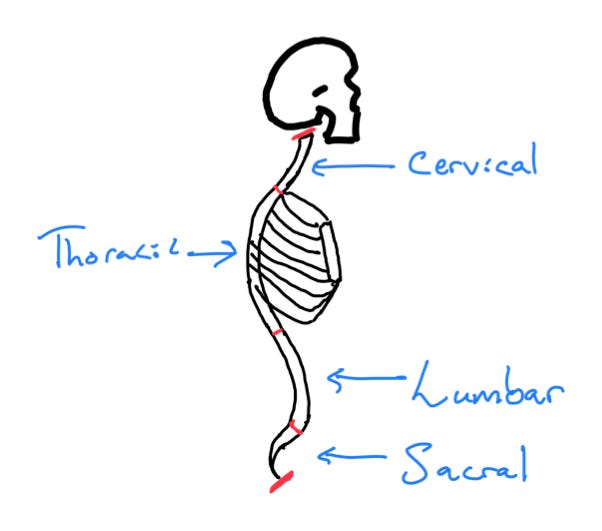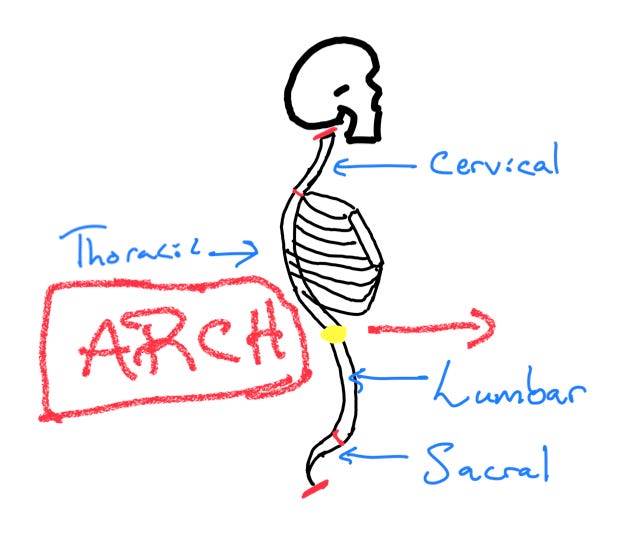Welcome to another post in my Know Your Habit series. If you’d like to stay in the loop and get the whole series, please take a second to subscribe! It’s free!
Know Your Habit
The purpose of this series is to give you a better idea of who you are and what you are doing. If you would like more context on what I’m covering, please check out The Rubrics of the Alexander Technique.
Last week, I posted this article on the habits of the head. This week, I’ll be talking about arching the back and lifting the chest and how they relate to the spine as a whole.
The 4 Curves of the Spine
In the drawing above you can see a skull with a spine and rib cage. The spine is a collection of vertebrae that arrange themselves into 4 curves: the cervical (7 vertebrae), thoracic (12), lumbar (5), and sacral (5 fused vertebrae). These bones are quite flexible and are separated by discs that function as shock absorbers for the back.
The red lines drawn above depict the inflection points on the S curve of the spine (the point where the curve changes from concave to convex). If you look at the blue arrows, they are pointing to the relative maximum points of the respective curves. Having a sense of these 9 points on your own back is a very helpful tool to have and would be wonderful additions to your Inner Sherlock.
The arrangement of the bones into these 4 curves can happen in either an optimal way for supporting weight or a suboptimal way. If you think your back is arranged in a suboptimal way, please don’t fret! There’s either a way to improve your health or a way to better understand what is happening with your back so that you can make healthier choices for your life.
Arching the Back
In the drawing above, I have given our dummy a slight arch in the back. You can see how far I’ve pushed the lumbar and sacral curves forward by seeing how the lower spine has come closer to the lumbar and sacral blue lines.
This arch in the back cannot live in isolation. When this yellow point pushes forward, weight is loaded into the front portion of the hip and the legs get quite tight. It tends to hurt and folks tend to start thinking they have a problem with their hips only.
You’ll see a ton of courses in the online help world advertising a focus in hip flexibility. Hip flexibility is good. Not knowing that the pain includes the organisation of all of the stuff and things on top of the hip and below the hip is not good.
Lifting the Chest
AKA The Broadway Chest
In this drawing, I have kept the cervical, lumbar, and sacral curves in their original place and have slightly lifted the breast bone along the forward and up line of the red arrow. I would say that this rib cage is pitching up if I were using my helicopter direction terminology.
When we pitch up in the rib cage, the thoracic spine has a tendency to flatten its curve. This tends to transfer to all of the curves of the back. Everything gets rigid and the breath gets fairly shallow or a habitual sighing creeps in. I have NOT drawn that chain of events because I want your eye drawn to the ribs.
Can You Do The Twist?
In a series of articles I wrote last year, I attempted to contort myself into these various shapes to demonstrate my meaning. I think it was partially successful, but I could not get the type of striking visual that I wanted. In truth, these arches and lifts can be quite subtle and can be masked by a lean or by the eyes getting drawn into shoulder asymmetry (or insert any other factor you like).
In the above ultra bodacious model lineup I have posed Mr. Yellow and Mr. White with various twists and pitches and arches in the back. Mr. Blue is relatively ok but his head looks a teeny tiny bit heavy to me. What I cannot show with these models is how weight can collapse on one side of the back and lift on the other. You would see this in yourself via a tilt in the hips to the left or right.
I’ll have to save that topic for another day.
See It. Name It. Know It.
If you’re a regular reader of this blog, you’ll know that I really haven’t spent much time on exercises to fix specific problems. It’s not that I discount the value in that. Far from it. It’s just that I want you to first be able to spend some time walking around in your own skin and learning to feel your own habitual pulls.
Walk around and take that unknown feeling into a named and - at least partially - known habit. Make no attempt to correct it.
Feel how gross it is.
Feel how heavy and stiff it may be.
This has to be the first step that you take before you can have any lasting and positive changes in your life.
So if you feel like 💩 today, take solace in the knowledge that your 💩 now has a smiley face attached to it!
Get In Touch
Thanks for reading “Know Your Habit: Part 2“! If you’re in NYC, you may learn more about my private teaching practice at johndalto.com.
If you’d like to book any lesson time with me, you can find my booking link here.







Another great piece that helps me on my body journey.